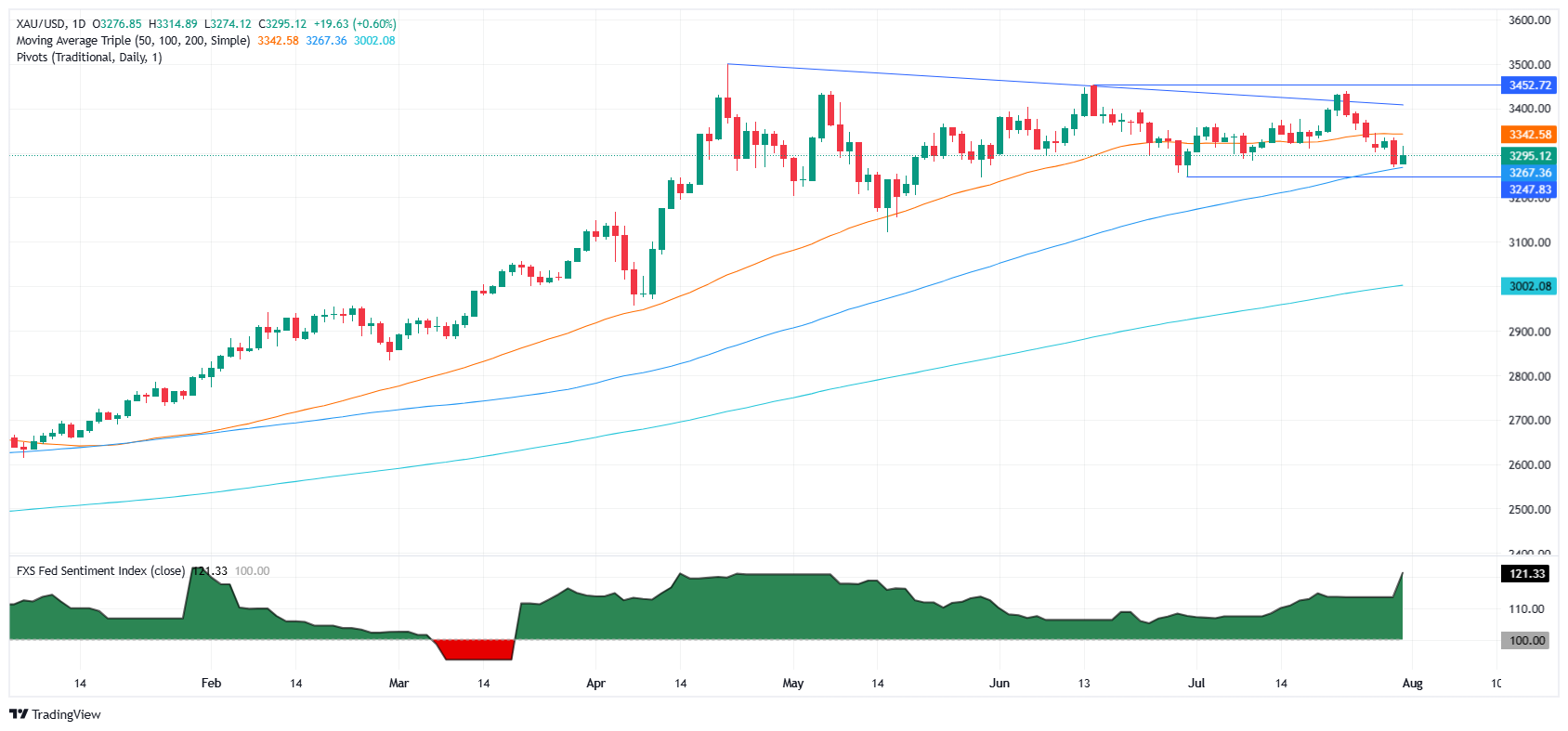Gold price rebounds ahead of NFP despite firm USD, Fed hold
- Gold price rises 0.61% to $3,296 after hitting July lows near $3,268.
- Fed holds rates at 4.25%-4.50% in 9–2 vote; Powell pushes back on September cut.
- Core PCE inflation ticks up to 2.8% YoY; Initial Jobless Claims fall to 218K.
- XAU/USD’s rebound driven by dip-buying and oversold conditions despite firm USD.
Gold prices recovered on Thursday after the Federal Reserve (Fed) held rates unchanged, as the August 1 trade deadline imposed by US President Donald Trump looms. The Greenback remains steady on a tranche of good economic data, though the XAU/USD trades at $3,296, gaining 0.61%.
Yesterday, the Fed maintained the fed funds rate at the 4.25%-4.50% range on a 9-2 split decision, with Governors Bowman and Waller opting for a 25-bps rate cut. Besides this, the Fed Chair Jerome Powell pushed back against Trump’s comments that they might ease policy in September and said that they would adopt a meeting-by-meeting approach.
In other news, the economic docket in the United States (US) was busy with a jump in the Fed’s preferred inflation gauge, the core Personal Consumption Expenditures (PCE) Price Index. Alongside that, strong jobs data showed that Americans filing for unemployment benefits dipped. This hints at the US central bank’s view that maximum employment has been achieved, further justifying the current policy stance.
In trade news, the US and Mexico reached a 90-day extension for the same deal of 25% tariffs due to fentanyl, 25% on cars, and 50% on steel, aluminum and copper. Meanwhile, the agreement between South Korea and the US on Wednesday continues to ease tensions regarding trade negotiations.
Even though trade uncertainty has diminished, Bullion’s plunge following the Fed’s decision seems to have taken the yellow metal to oversold levels. Hence, Gold buyers stepped in near July lows of $3,268, driving XAU/USD spot price toward the $3,300 figure.
Traders gear up for Friday’s Nonfarm Payroll (NFP) figures for July, along with the announcement of the ISM Manufacturing PMI and the final University of Michigan (UoM) Consumer Sentiment index.
Daily digest market movers: Gold underpinned by falling US yields
- Gold price climbs as US Treasury yields fall. The US 10-year Treasury note is down nearly three basis points at 4.344%. US real yields, which are calculated from the nominal yield by subtracting inflation expectations, are at 1.922%, also down three bps.
- The US Dollar Index (DXY), which tracks the buck’s performance against six currencies, is up 0.10% at 99.99.
- Initial Jobless Claims for the week ending July 26 dipped to 218K, coming up better than the expected 224K ahead of the release of the July Nonfarm Payrolls report on Friday, with economists expecting that the economy would add 110K new jobs.
- The Fed’s preferred inflation gauge, the core PCE, rose by 2.8% YoY in June, up from May’s estimate of 2.7%. Headline PCE jumped from 2.3% to 2.6% YoY, above forecasts of 2.5%.
- On Wednesday, the Fed monetary policy statement revealed that growth of economic activity has moderated in the first half, though the Unemployment Rate remains low and inflation is “somewhat elevated.”
- The statement revealed the committee’s commitment to achieve maximum employment and inflation at a rate of 2% and acknowledged that “Uncertainty about the economic outlook remains elevated.”
- Gross Domestic Product (GDP) in the second quarter of the US crushed the mark and rose by 3% QoQ in Q2 2025. The data justified Fed Chair Powell's saying that the economy is not behaving as if monetary policy were restrictive.
- Although the print is positive, the report showed that consumer spending weakened and business investment slowed sharply. Reuters revealed that most economists estimate GDP for the whole year at 1.5%, below the 1.8% forecast by the Fed.
XAU/USD technical outlook: Gold nosedives but remains bullish above $3,250
Gold price is set to consolidate within the 100-day Simple Moving Average (SMA) at $3,250 and the $3,300 figure in the short term. Although the Relative Strength Index (RSI) is bearish, the index seems to have found a bottom. With that said, expect a recovery in the short term.
If XAU/USD clears the immediate resistance at $3,300, followed by the confluence of the 50 and 20-day SMAs around $3,339, expect a move toward $3,350. Once breached, $3,400 is up next. On the flip side, if XAU/USD tumbles below the 100-day SMA, expect a drop toward $3,200.

Gold FAQs
Gold has played a key role in human’s history as it has been widely used as a store of value and medium of exchange. Currently, apart from its shine and usage for jewelry, the precious metal is widely seen as a safe-haven asset, meaning that it is considered a good investment during turbulent times. Gold is also widely seen as a hedge against inflation and against depreciating currencies as it doesn’t rely on any specific issuer or government.
Central banks are the biggest Gold holders. In their aim to support their currencies in turbulent times, central banks tend to diversify their reserves and buy Gold to improve the perceived strength of the economy and the currency. High Gold reserves can be a source of trust for a country’s solvency. Central banks added 1,136 tonnes of Gold worth around $70 billion to their reserves in 2022, according to data from the World Gold Council. This is the highest yearly purchase since records began. Central banks from emerging economies such as China, India and Turkey are quickly increasing their Gold reserves.
Gold has an inverse correlation with the US Dollar and US Treasuries, which are both major reserve and safe-haven assets. When the Dollar depreciates, Gold tends to rise, enabling investors and central banks to diversify their assets in turbulent times. Gold is also inversely correlated with risk assets. A rally in the stock market tends to weaken Gold price, while sell-offs in riskier markets tend to favor the precious metal.
The price can move due to a wide range of factors. Geopolitical instability or fears of a deep recession can quickly make Gold price escalate due to its safe-haven status. As a yield-less asset, Gold tends to rise with lower interest rates, while higher cost of money usually weighs down on the yellow metal. Still, most moves depend on how the US Dollar (USD) behaves as the asset is priced in dollars (XAU/USD). A strong Dollar tends to keep the price of Gold controlled, whereas a weaker Dollar is likely to push Gold prices up.

